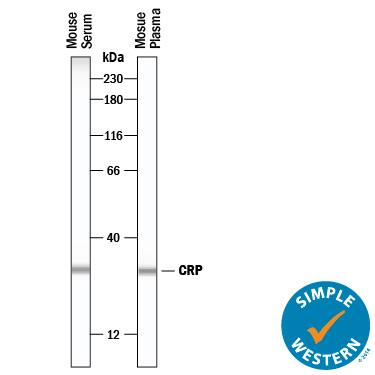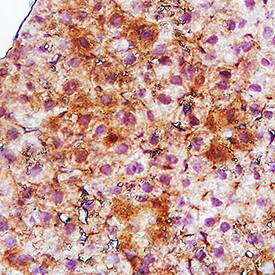Mouse C-Reactive Protein/CRP Antibody
R&D Systems, part of Bio-Techne | Catalog # AF1829


Key Product Details
Species Reactivity
Validated:
Cited:
Applications
Validated:
Cited:
Label
Antibody Source
Product Specifications
Immunogen
His20-Ser225
Accession # Q91XB3
Specificity
Clonality
Host
Isotype
Scientific Data Images for Mouse C-Reactive Protein/CRP Antibody
Detection of Mouse C‑Reactive Protein/CRP by Western Blot.
Western blot shows lysate of mouse serum. PVDF membrane was probed with 1 µg/mL of Goat Anti-Mouse C-Reactive Protein/CRP Antigen Affinity-purified Polyclonal Antibody (Catalog # AF1829) followed by HRP-conjugated Anti-Goat IgG Secondary Antibody (HAF017). A specific band was detected for C-Reactive Protein/CRP at approximately 25 kDa (as indicated). This experiment was conducted under reducing conditions and using Immunoblot Buffer Group 1.Detection of Mouse C-Reactive Protein/CRP by Simple WesternTM.
Simple Western lane view shows mouse serum and mouse plasma, loaded at 0.2 mg/mL. A specific band was detected for C-Reactive Protein/CRP at approximately 30 kDa (as indicated) using 10 µg/mL of Goat Anti-Mouse C-Reactive Protein/CRP Antigen Affinity-purified Polyclonal Antibody (Catalog # AF1829) . This experiment was conducted under reducing conditions and using the 12-230 kDa separation system.Detection of C-Reactive Protein/CRP in Mouse Liver.
C-Reactive Protein/CRP was detected in perfusion fixed paraffin-embedded sections of Mouse Liver using Goat Anti-Mouse C-Reactive Protein/CRP Antigen Affinity-purified Polyclonal Antibody (Catalog # AF1829) at 5 µg/mL for 1 hour at room temperature followed by incubation with the Anti-Goat IgG VisUCyte™ HRP Polymer Antibody (Catalog # VC004). Before incubation with the primary antibody, tissue was subjected to heat-induced epitope retrieval using VisUCyte Antigen Retrieval Reagent-Basic (Catalog # VCTS021). Tissue was stained using DAB (brown) and counterstained with hematoxylin (blue). Specific staining was localized to cytoplasm in hepatocytes. View our protocol for IHC Staining with VisUCyte HRP Polymer Detection Reagents.Applications for Mouse C-Reactive Protein/CRP Antibody
Immunohistochemistry
Sample: Perfusion fixed paraffin-embedded sections of Mouse Liver.
Simple Western
Sample: Mouse serum and mouse plasma
Western Blot
Sample: Mouse serum
Formulation, Preparation, and Storage
Purification
Reconstitution
Formulation
Shipping
Stability & Storage
- 12 months from date of receipt, -20 to -70 °C as supplied.
- 1 month, 2 to 8 °C under sterile conditions after reconstitution.
- 6 months, -20 to -70 °C under sterile conditions after reconstitution.
Background: C-Reactive Protein/CRP
C-reactive protein (CRP) is a member of the pentraxin family of plasma proteins that are part of the lectin fold superfamily of calcium-dependent, carbohydrate-binding proteins (1). CRP is named for its ability to bind to the C-polysaccharide of Strep. Pneumoniae. CRP is characterized by cyclic pentameric structure that contains five identical protomers/subunits, each exhibiting a lectin fold composed of two antiparallel beta-sheets with a fattened jellyroll topology. The mouse CRP precursor is 225 amino acids (aa) in length and contains a signal peptide of 19 aa with a mature polypeptide of 206 aa (2, 3). There is one intrachain disulfide bond and no N-linked glycosylation site(s). Although rat CRP is glycosylated at an N-linked site, human, mouse and rabbit CRP all appear to be non-glycosylated (1, 4, 5). In mouse, the protomers are assembled non-covalently to form the pentameter; in rat, two of the five protomers are covalently linked (6). Mature mouse CRP shares 74%, 71%, 79%, and 68% aa sequence identity with rat, human, hamster and guinea pig CRP, respectively. In human, CRP is induced in hepatocytes principally by IL-6 (1). In mouse, IL-6 has very little effect. Mouse CRP induction is due principally to IL-1 (1, 7), with another pentraxin, SAP, being IL-6 inducible (7). CRP exhibits calcium-dependent binding to ligands. Phosphocholine (PCh), a constituent of many bacterial and fungal cell walls, is a principal ligand of CRP. CRP will also bind to the cell membrane of injured necrotic and apoptotic cells. In this context, CRP acts as an opsonin, binding to Fc gamma RI and II, and serves as an antiinflammatory agent (8).
References
- Hirschfield, G.M. and M.B. Pepys (2003) Q.J. Med 96:793.
- Whitehead, A.S. et al. (1990) Biochem. J. 266:283.
- Ohnishi, S. et al. (1988) Biochem. Biophys. Res. Commun. 156:814.
- Sambasivam, H. et al. (1993) J. Biol. Chem. 268:10007.
- Black, S. et al. (2004) J. Biol. Chem. 279:48487.
- Rassouli, M. et al. (1992) J. Biol. Chem. 267:2947.
- Ku, N.-O. and R.F. Mortensen (1993) Cytokine 5:319.
- Mold, C. et al. (2002) J. Immunol. 169:7019.
Alternate Names
Gene Symbol
UniProt
Additional C-Reactive Protein/CRP Products
Product Documents for Mouse C-Reactive Protein/CRP Antibody
Product Specific Notices for Mouse C-Reactive Protein/CRP Antibody
For research use only

